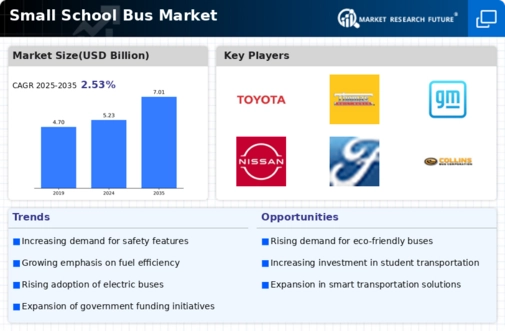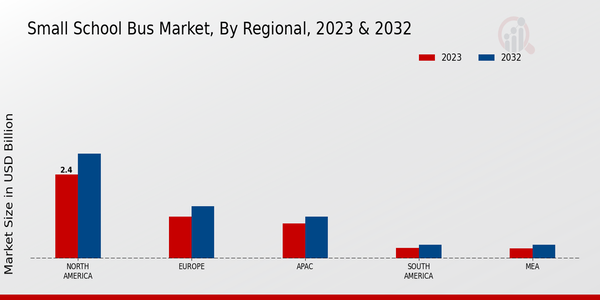Market Growth Projections
The Global Small School Bus Market Industry is anticipated to experience robust growth in the coming years. Projections indicate that the market will reach 5.23 USD Billion in 2024 and is expected to grow to 7.01 USD Billion by 2035. This growth trajectory suggests a compound annual growth rate (CAGR) of 2.69% from 2025 to 2035. Such figures reflect the increasing investment in student transportation solutions, driven by factors such as safety regulations, technological advancements, and environmental considerations. The market's expansion may present opportunities for manufacturers and stakeholders to innovate and adapt to the evolving needs of educational institutions.
Technological Advancements in Bus Design
Technological advancements play a crucial role in shaping the Global Small School Bus Market Industry. Innovations in safety features, fuel efficiency, and emissions reduction are becoming increasingly prevalent. For instance, the integration of advanced driver-assistance systems (ADAS) enhances safety by minimizing accidents. Additionally, the shift towards electric and hybrid buses aligns with global sustainability goals, potentially attracting environmentally conscious school districts. As these technologies evolve, they may lead to a more competitive market landscape, encouraging manufacturers to invest in research and development. This focus on innovation could drive the market's growth trajectory, appealing to a broader range of educational institutions.
Increasing Demand for Student Transportation
The Global Small School Bus Market Industry experiences a notable increase in demand for student transportation solutions. As educational institutions prioritize student safety and accessibility, the need for reliable transportation options becomes paramount. In 2024, the market is projected to reach 5.23 USD Billion, reflecting a growing recognition of the importance of safe and efficient transport for students. This trend is further supported by government initiatives aimed at enhancing school transportation infrastructure, which may contribute to the expansion of the small school bus segment. Consequently, the industry is likely to witness sustained growth as more schools invest in modern, compliant vehicles.
Government Regulations and Funding Initiatives
Government regulations and funding initiatives significantly influence the Global Small School Bus Market Industry. Many countries implement stringent safety standards for school transportation, compelling schools to upgrade their fleets. Additionally, various government programs provide financial assistance for purchasing new buses, particularly those that meet environmental standards. These initiatives not only enhance safety but also promote the adoption of greener technologies. As a result, the market is likely to benefit from increased investments in small school buses, facilitating a transition towards more sustainable and efficient transportation solutions for students. This regulatory environment may bolster market growth in the coming years.
Growing Enrollment in Educational Institutions
The Global Small School Bus Market Industry is poised for growth due to the increasing enrollment in educational institutions worldwide. As populations grow and more families prioritize education, schools face the challenge of accommodating larger student bodies. This surge in enrollment necessitates expanded transportation solutions, particularly in urban and suburban areas where public transport may be limited. Consequently, the demand for small school buses is likely to rise, as they offer a practical solution for transporting students safely and efficiently. The projected compound annual growth rate (CAGR) of 2.69% from 2025 to 2035 suggests a sustained upward trend in market demand.
Rising Awareness of Environmental Sustainability
The rising awareness of environmental sustainability is reshaping the Global Small School Bus Market Industry. Educational institutions are increasingly recognizing their role in promoting eco-friendly practices, leading to a shift towards electric and hybrid school buses. This transition aligns with global efforts to reduce carbon emissions and combat climate change. As schools adopt greener transportation options, the market is expected to expand, with projections indicating a growth to 7.01 USD Billion by 2035. This trend not only reflects a commitment to sustainability but also appeals to parents and communities advocating for environmentally responsible choices in student transportation.












